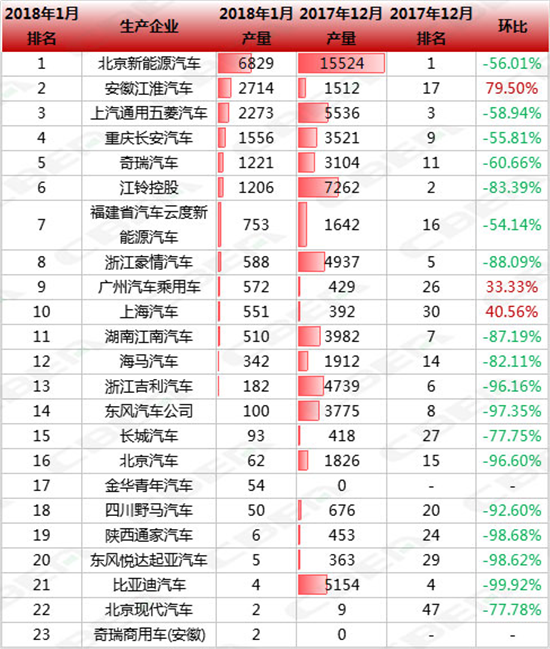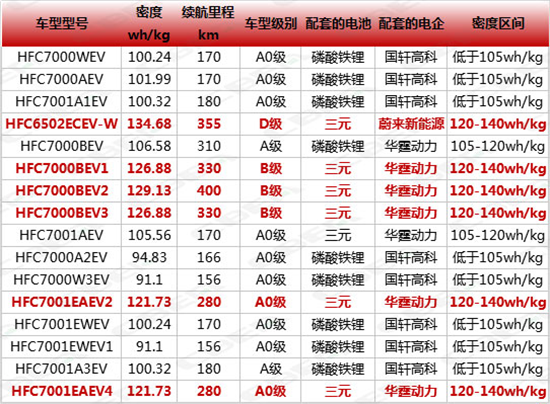With the rapid advancement of new energy vehicle technology and the strong support from national policies, China's new energy vehicle industry is experiencing a significant boom. Since November 2017, there have been three consecutive months of high production growth. According to data from the Research Department of the Power Battery Application Branch, in January 2018, the production of new energy passenger vehicles reached 33,626 units, with 19,675 being pure electric models, accounting for 58.51% of the total. The remaining 13,951 units were plug-in hybrid models, making up 41.49%.
Looking at the performance of different manufacturers, in January 2018, 23 companies produced pure electric passenger cars, with three of them seeing a notable increase compared to the previous quarter. Anhui Jianghuai Automobile Group experienced the most significant growth, with a 79.5% increase. Guangzhou Automobiles saw a 33.33% rise, while Shanghai Automotive Co., Ltd. recorded a 40.56% month-on-month increase.

*Source: Research Department of Power Battery Application Branch*
From the data, it’s clear that Jianghuai Automobile, one of the pioneers in domestic new energy vehicle technology, ranked second in output but showed impressive growth. Two key factors contributed to this success:
**IEV6E's Outstanding Performance**
As the first pure electric mini-vehicle from JAC, the IEV6E was a big hit in 2017, with a total of 23,328 units produced, making up 85.16% of JAC’s overall production. In January 2018, it produced 2,478 units, a 210.92% increase from the previous period. Its high cost-performance ratio, quality, and attractive design made it popular among consumers.
**Energy Density Challenges**
In 2017, Jianghuai Automobile launched 16 models of pure electric passenger vehicles under the "Catalogue of Recommended Vehicles for Promotion and Application of New Energy Vehicles." These models varied in energy density, ranging from below 105 Wh/kg to over 140 Wh/kg. The lower energy density models (A0 class) used Guoxuan High-tech lithium iron phosphate batteries, offering a range of 156–180 km. Mid-range models (105–120 Wh/kg) had a longer range, up to 310 km, while higher energy density models (120–140 Wh/kg) offered ranges between 280–400 km, using ternary lithium batteries.

*Source: Research Department of Power Battery Application Branch*
Under the new subsidy policy in 2018, mini-vehicles faced significant cuts in financial support. Vehicles with a range below 300 km received much lower subsidies, while those above 300 km and with energy density exceeding 140 Wh/kg qualified for higher incentives. This meant that only vehicles meeting these strict criteria could qualify for the full subsidy. As a result, many automakers rushed to prepare before the transition period ended on June 11, 2018.
Overall, as lithium iron phosphate battery technology reaches its limits, achieving energy densities above 140 Wh/kg becomes increasingly challenging. This shift favors ternary lithium batteries, which are expected to gain more market share in the new energy passenger car sector. In the long run, ternary batteries will likely dominate the medium-to-large-sized vehicle segment due to their higher energy density and extended driving range.
Author: Research Team
High definition LED displays or HD led screen also called Small pixel pitch led display screens represents the latest and
top technology of LED display industrial, they are widely used in high-end
conference
rooms, TV studios, the government mansion, etc. With 400mm*300mm cabinet
size, it is very easy to get 16:9 or 4:3 display ratio. As the 400*300mm cabinet is light weight and has high precision in cabinet size.
HD LED Video Wall ,HD LED Video Wall, indoor LED Display, Indoor LED screen
Shenzhen Priva Tech Co., Ltd. , https://www.privaled.com
![<?echo $_SERVER['SERVER_NAME'];?>](/template/twentyseventeen/skin/images/header.jpg)